Economic Policy Formulation for Sri Lanka: A Comprehensive Analysis
VerifiedAdded on 2022/06/07
|20
|5253
|29
Report
AI Summary
This report provides a comprehensive analysis of economic policy formulation for Sri Lanka, addressing key areas crucial for sustainable economic development. It begins by highlighting the importance of well-defined economic policies, contrasting Sri Lanka's economic trajectory with Singapore's. The report emphasizes the inclusion of non-economic aspects, such as social, cultural, and political dimensions, which significantly influence economic growth. It then delves into the importance of a consistent and efficient tax structure, using Estonia's tax system as a benchmark. The analysis further examines revenue generation strategies and the integration of the legal system with the economy, drawing comparisons with countries like Denmark. The report also addresses the impacts of geopolitical pressures and strategies to tackle potential future epidemics and pandemics, particularly in light of the COVID-19 pandemic's economic fallout. It concludes by offering recommendations for policymakers to formulate effective long-term economic strategies that promote stability, growth, and societal development in Sri Lanka.
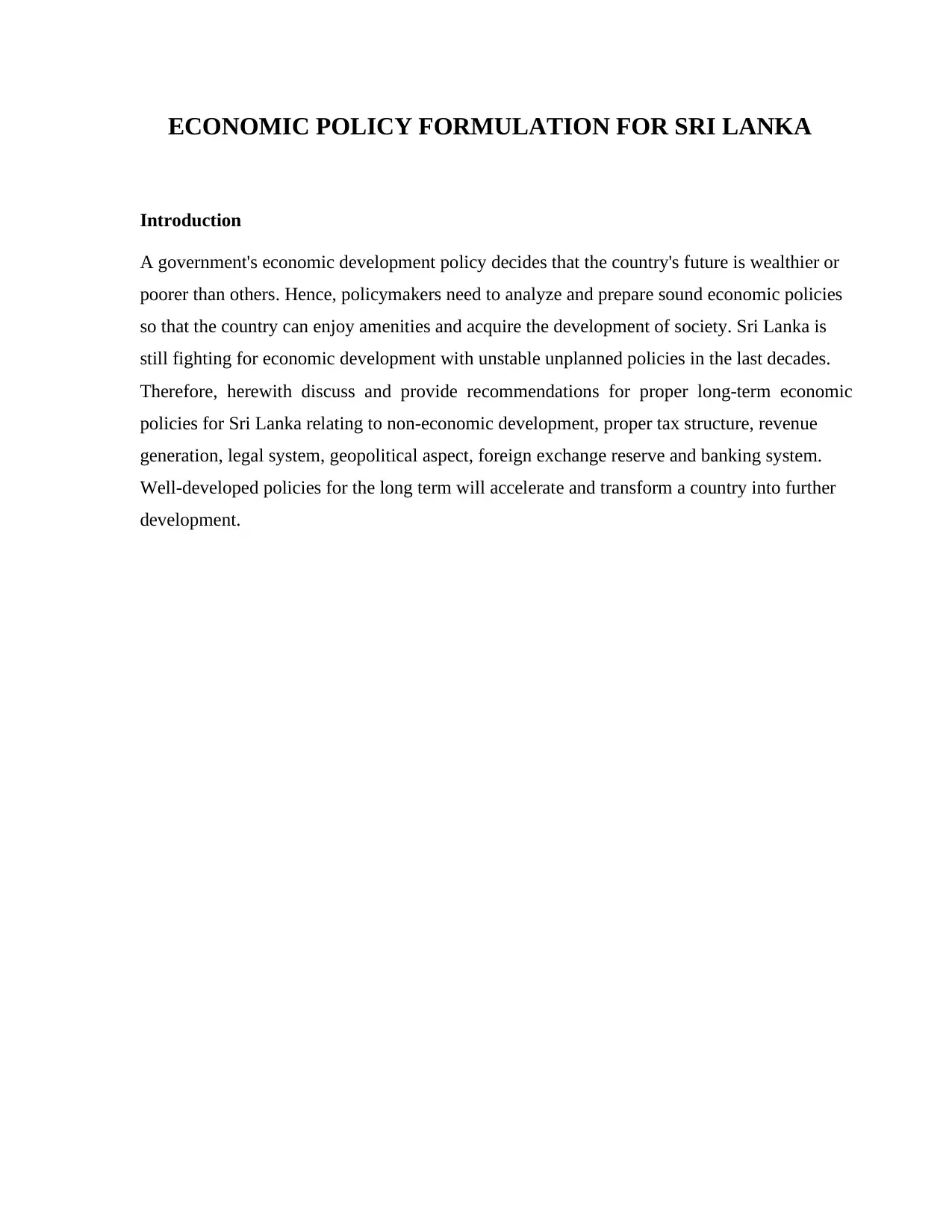
ECONOMIC POLICY FORMULATION FOR SRI LANKA
Introduction
A government's economic development policy decides that the country's future is wealthier or
poorer than others. Hence, policymakers need to analyze and prepare sound economic policies
so that the country can enjoy amenities and acquire the development of society. Sri Lanka is
still fighting for economic development with unstable unplanned policies in the last decades.
Therefore, herewith discuss and provide recommendations for proper long-term economic
policies for Sri Lanka relating to non-economic development, proper tax structure, revenue
generation, legal system, geopolitical aspect, foreign exchange reserve and banking system.
Well-developed policies for the long term will accelerate and transform a country into further
development.
Introduction
A government's economic development policy decides that the country's future is wealthier or
poorer than others. Hence, policymakers need to analyze and prepare sound economic policies
so that the country can enjoy amenities and acquire the development of society. Sri Lanka is
still fighting for economic development with unstable unplanned policies in the last decades.
Therefore, herewith discuss and provide recommendations for proper long-term economic
policies for Sri Lanka relating to non-economic development, proper tax structure, revenue
generation, legal system, geopolitical aspect, foreign exchange reserve and banking system.
Well-developed policies for the long term will accelerate and transform a country into further
development.
Paraphrase This Document
Need a fresh take? Get an instant paraphrase of this document with our AI Paraphraser
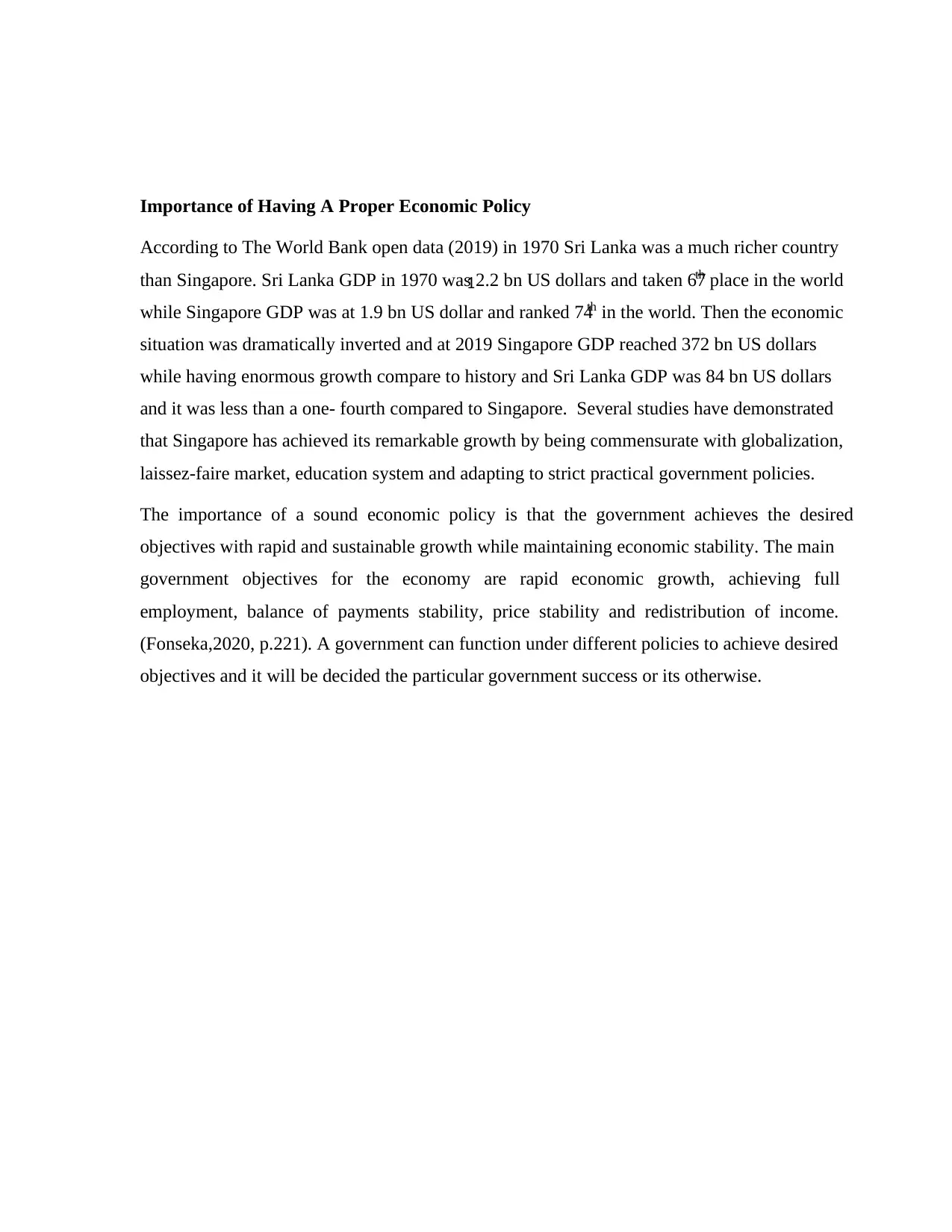
Importance of Having A Proper Economic Policy
According to The World Bank open data (2019) in 1970 Sri Lanka was a much richer country
than Singapore. Sri Lanka GDP in 1970 was 2.2 bn US dollars and taken 67th place in the world
while Singapore GDP was at 1.9 bn US dollar and ranked 74th in the world. Then the economic
situation was dramatically inverted and at 2019 Singapore GDP reached 372 bn US dollars
while having enormous growth compare to history and Sri Lanka GDP was 84 bn US dollars
and it was less than a one- fourth compared to Singapore. Several studies have demonstrated
that Singapore has achieved its remarkable growth by being commensurate with globalization,
laissez-faire market, education system and adapting to strict practical government policies.
The importance of a sound economic policy is that the government achieves the desired
objectives with rapid and sustainable growth while maintaining economic stability. The main
government objectives for the economy are rapid economic growth, achieving full
employment, balance of payments stability, price stability and redistribution of income.
(Fonseka,2020, p.221). A government can function under different policies to achieve desired
objectives and it will be decided the particular government success or its otherwise.
1
According to The World Bank open data (2019) in 1970 Sri Lanka was a much richer country
than Singapore. Sri Lanka GDP in 1970 was 2.2 bn US dollars and taken 67th place in the world
while Singapore GDP was at 1.9 bn US dollar and ranked 74th in the world. Then the economic
situation was dramatically inverted and at 2019 Singapore GDP reached 372 bn US dollars
while having enormous growth compare to history and Sri Lanka GDP was 84 bn US dollars
and it was less than a one- fourth compared to Singapore. Several studies have demonstrated
that Singapore has achieved its remarkable growth by being commensurate with globalization,
laissez-faire market, education system and adapting to strict practical government policies.
The importance of a sound economic policy is that the government achieves the desired
objectives with rapid and sustainable growth while maintaining economic stability. The main
government objectives for the economy are rapid economic growth, achieving full
employment, balance of payments stability, price stability and redistribution of income.
(Fonseka,2020, p.221). A government can function under different policies to achieve desired
objectives and it will be decided the particular government success or its otherwise.
1
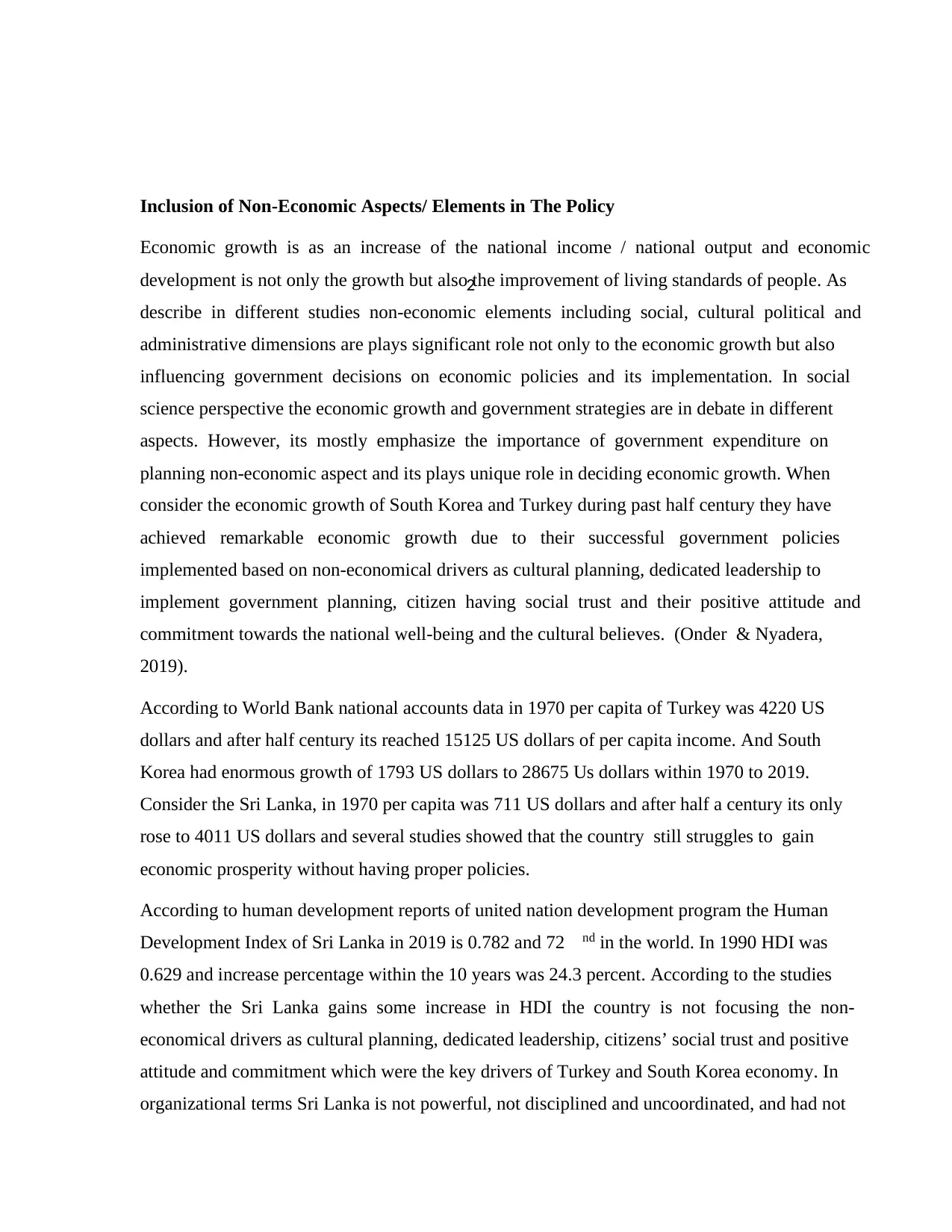
Inclusion of Non-Economic Aspects/ Elements in The Policy
Economic growth is as an increase of the national income / national output and economic
development is not only the growth but also the improvement of living standards of people. As
describe in different studies non-economic elements including social, cultural political and
administrative dimensions are plays significant role not only to the economic growth but also
influencing government decisions on economic policies and its implementation. In social
science perspective the economic growth and government strategies are in debate in different
aspects. However, its mostly emphasize the importance of government expenditure on
planning non-economic aspect and its plays unique role in deciding economic growth. When
consider the economic growth of South Korea and Turkey during past half century they have
achieved remarkable economic growth due to their successful government policies
implemented based on non-economical drivers as cultural planning, dedicated leadership to
implement government planning, citizen having social trust and their positive attitude and
commitment towards the national well-being and the cultural believes. (Onder & Nyadera,
2019).
According to World Bank national accounts data in 1970 per capita of Turkey was 4220 US
dollars and after half century its reached 15125 US dollars of per capita income. And South
Korea had enormous growth of 1793 US dollars to 28675 Us dollars within 1970 to 2019.
Consider the Sri Lanka, in 1970 per capita was 711 US dollars and after half a century its only
rose to 4011 US dollars and several studies showed that the country still struggles to gain
economic prosperity without having proper policies.
According to human development reports of united nation development program the Human
Development Index of Sri Lanka in 2019 is 0.782 and 72 nd in the world. In 1990 HDI was
0.629 and increase percentage within the 10 years was 24.3 percent. According to the studies
whether the Sri Lanka gains some increase in HDI the country is not focusing the non-
economical drivers as cultural planning, dedicated leadership, citizens’ social trust and positive
attitude and commitment which were the key drivers of Turkey and South Korea economy. In
organizational terms Sri Lanka is not powerful, not disciplined and uncoordinated, and had not
2
Economic growth is as an increase of the national income / national output and economic
development is not only the growth but also the improvement of living standards of people. As
describe in different studies non-economic elements including social, cultural political and
administrative dimensions are plays significant role not only to the economic growth but also
influencing government decisions on economic policies and its implementation. In social
science perspective the economic growth and government strategies are in debate in different
aspects. However, its mostly emphasize the importance of government expenditure on
planning non-economic aspect and its plays unique role in deciding economic growth. When
consider the economic growth of South Korea and Turkey during past half century they have
achieved remarkable economic growth due to their successful government policies
implemented based on non-economical drivers as cultural planning, dedicated leadership to
implement government planning, citizen having social trust and their positive attitude and
commitment towards the national well-being and the cultural believes. (Onder & Nyadera,
2019).
According to World Bank national accounts data in 1970 per capita of Turkey was 4220 US
dollars and after half century its reached 15125 US dollars of per capita income. And South
Korea had enormous growth of 1793 US dollars to 28675 Us dollars within 1970 to 2019.
Consider the Sri Lanka, in 1970 per capita was 711 US dollars and after half a century its only
rose to 4011 US dollars and several studies showed that the country still struggles to gain
economic prosperity without having proper policies.
According to human development reports of united nation development program the Human
Development Index of Sri Lanka in 2019 is 0.782 and 72 nd in the world. In 1990 HDI was
0.629 and increase percentage within the 10 years was 24.3 percent. According to the studies
whether the Sri Lanka gains some increase in HDI the country is not focusing the non-
economical drivers as cultural planning, dedicated leadership, citizens’ social trust and positive
attitude and commitment which were the key drivers of Turkey and South Korea economy. In
organizational terms Sri Lanka is not powerful, not disciplined and uncoordinated, and had not
2
⊘ This is a preview!⊘
Do you want full access?
Subscribe today to unlock all pages.

Trusted by 1+ million students worldwide
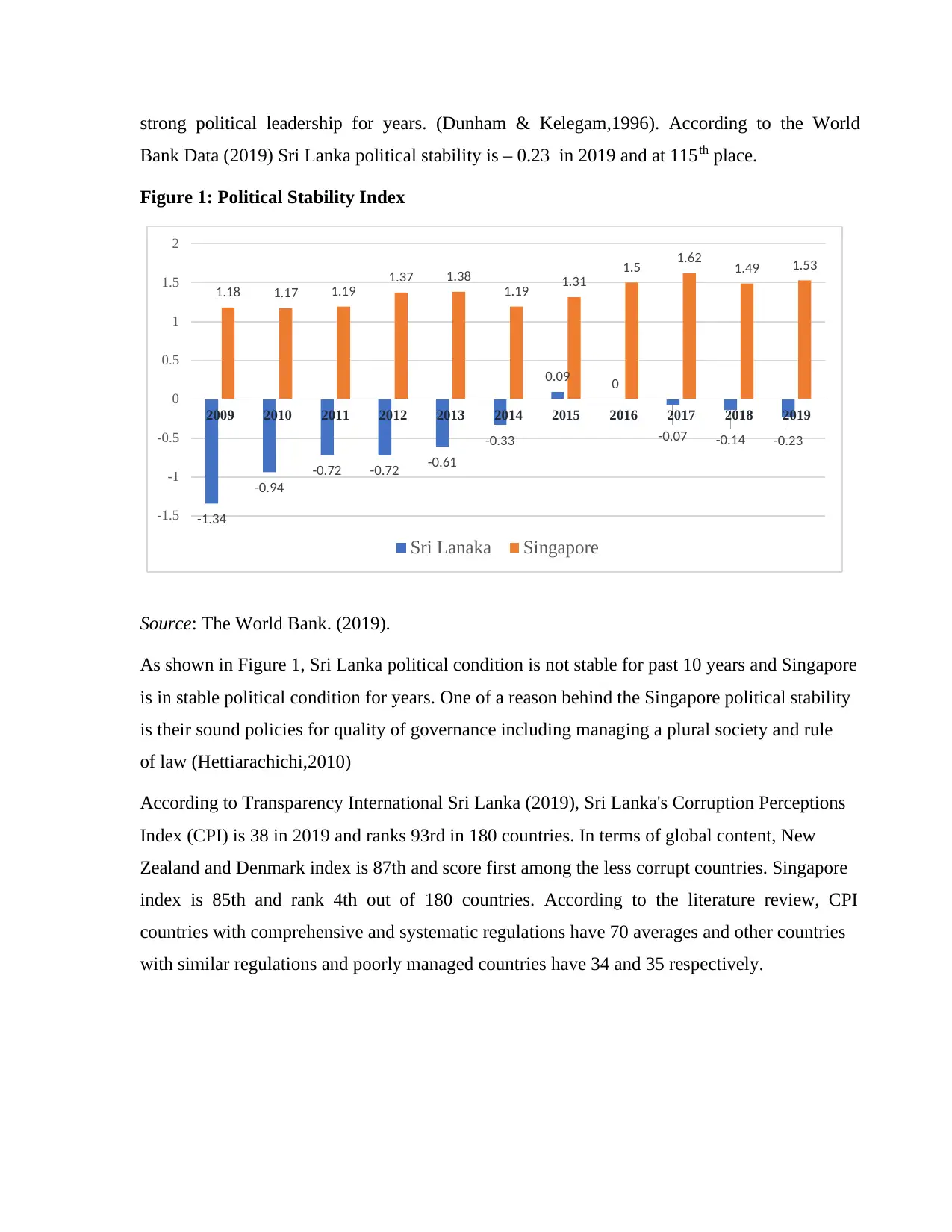
strong political leadership for years. (Dunham & Kelegam,1996). According to the World
Bank Data (2019) Sri Lanka political stability is – 0.23 in 2019 and at 115th place.
Figure 1: Political Stability Index
Source: The World Bank. (2019).
As shown in Figure 1, Sri Lanka political condition is not stable for past 10 years and Singapore
is in stable political condition for years. One of a reason behind the Singapore political stability
is their sound policies for quality of governance including managing a plural society and rule
of law (Hettiarachichi,2010)
According to Transparency International Sri Lanka (2019), Sri Lanka's Corruption Perceptions
Index (CPI) is 38 in 2019 and ranks 93rd in 180 countries. In terms of global content, New
Zealand and Denmark index is 87th and score first among the less corrupt countries. Singapore
index is 85th and rank 4th out of 180 countries. According to the literature review, CPI
countries with comprehensive and systematic regulations have 70 averages and other countries
with similar regulations and poorly managed countries have 34 and 35 respectively.
-1.34
-0.94
-0.72 -0.72 -0.61
-0.33
0.09 0
-0.07 -0.14 -0.23
1.18 1.17 1.19
1.37 1.38
1.19 1.31
1.5 1.62 1.49 1.53
-1.5
-1
-0.5
0
0.5
1
1.5
2
2009 2010 2011 2012 2013 2014 2015 2016 2017 2018 2019
Sri Lanaka Singapore
Bank Data (2019) Sri Lanka political stability is – 0.23 in 2019 and at 115th place.
Figure 1: Political Stability Index
Source: The World Bank. (2019).
As shown in Figure 1, Sri Lanka political condition is not stable for past 10 years and Singapore
is in stable political condition for years. One of a reason behind the Singapore political stability
is their sound policies for quality of governance including managing a plural society and rule
of law (Hettiarachichi,2010)
According to Transparency International Sri Lanka (2019), Sri Lanka's Corruption Perceptions
Index (CPI) is 38 in 2019 and ranks 93rd in 180 countries. In terms of global content, New
Zealand and Denmark index is 87th and score first among the less corrupt countries. Singapore
index is 85th and rank 4th out of 180 countries. According to the literature review, CPI
countries with comprehensive and systematic regulations have 70 averages and other countries
with similar regulations and poorly managed countries have 34 and 35 respectively.
-1.34
-0.94
-0.72 -0.72 -0.61
-0.33
0.09 0
-0.07 -0.14 -0.23
1.18 1.17 1.19
1.37 1.38
1.19 1.31
1.5 1.62 1.49 1.53
-1.5
-1
-0.5
0
0.5
1
1.5
2
2009 2010 2011 2012 2013 2014 2015 2016 2017 2018 2019
Sri Lanaka Singapore
Paraphrase This Document
Need a fresh take? Get an instant paraphrase of this document with our AI Paraphraser
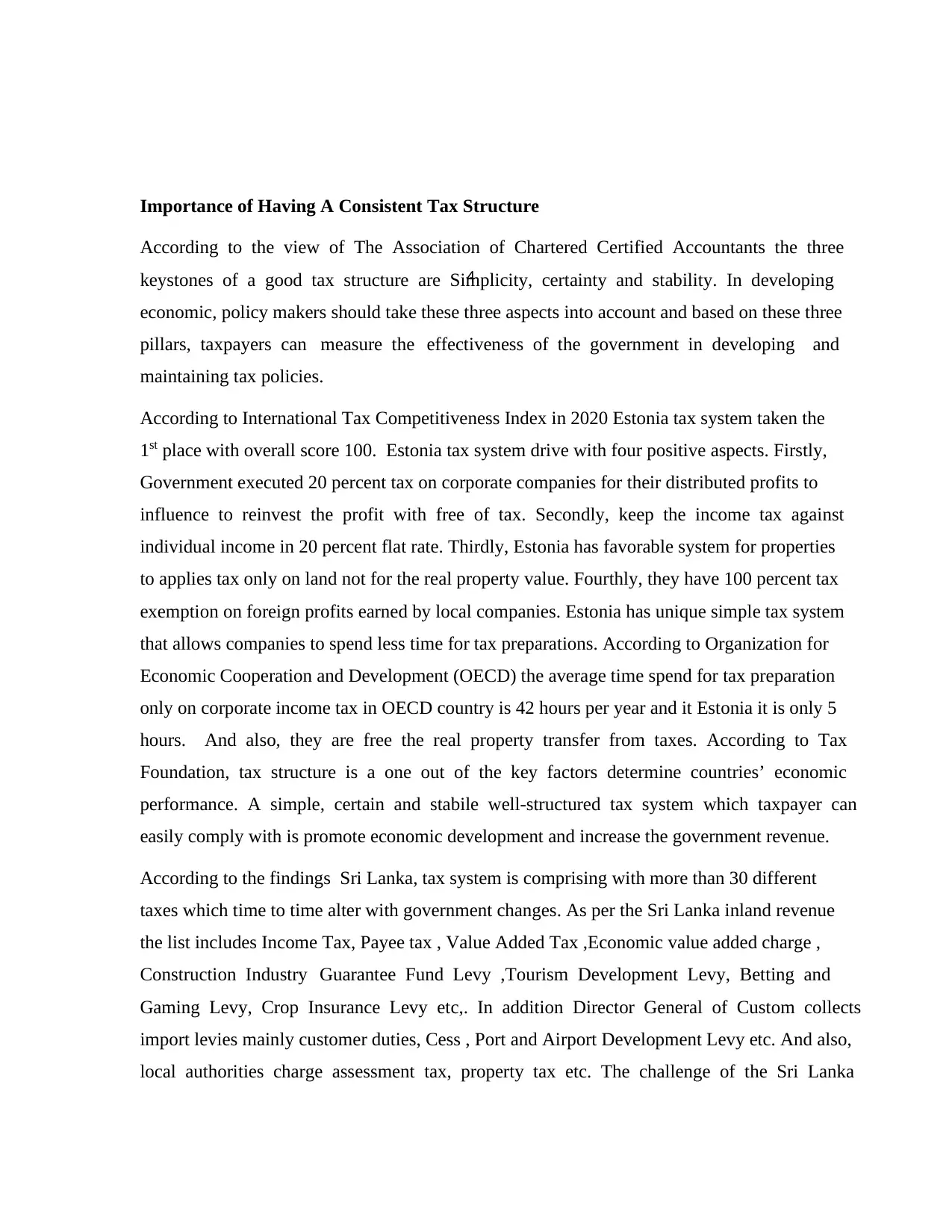
Importance of Having A Consistent Tax Structure
According to the view of The Association of Chartered Certified Accountants the three
keystones of a good tax structure are Simplicity, certainty and stability. In developing
economic, policy makers should take these three aspects into account and based on these three
pillars, taxpayers can measure the effectiveness of the government in developing and
maintaining tax policies.
According to International Tax Competitiveness Index in 2020 Estonia tax system taken the
1st place with overall score 100. Estonia tax system drive with four positive aspects. Firstly,
Government executed 20 percent tax on corporate companies for their distributed profits to
influence to reinvest the profit with free of tax. Secondly, keep the income tax against
individual income in 20 percent flat rate. Thirdly, Estonia has favorable system for properties
to applies tax only on land not for the real property value. Fourthly, they have 100 percent tax
exemption on foreign profits earned by local companies. Estonia has unique simple tax system
that allows companies to spend less time for tax preparations. According to Organization for
Economic Cooperation and Development (OECD) the average time spend for tax preparation
only on corporate income tax in OECD country is 42 hours per year and it Estonia it is only 5
hours. And also, they are free the real property transfer from taxes. According to Tax
Foundation, tax structure is a one out of the key factors determine countries’ economic
performance. A simple, certain and stabile well-structured tax system which taxpayer can
easily comply with is promote economic development and increase the government revenue.
According to the findings Sri Lanka, tax system is comprising with more than 30 different
taxes which time to time alter with government changes. As per the Sri Lanka inland revenue
the list includes Income Tax, Payee tax , Value Added Tax ,Economic value added charge ,
Construction Industry Guarantee Fund Levy ,Tourism Development Levy, Betting and
Gaming Levy, Crop Insurance Levy etc,. In addition Director General of Custom collects
import levies mainly customer duties, Cess , Port and Airport Development Levy etc. And also,
local authorities charge assessment tax, property tax etc. The challenge of the Sri Lanka
4
According to the view of The Association of Chartered Certified Accountants the three
keystones of a good tax structure are Simplicity, certainty and stability. In developing
economic, policy makers should take these three aspects into account and based on these three
pillars, taxpayers can measure the effectiveness of the government in developing and
maintaining tax policies.
According to International Tax Competitiveness Index in 2020 Estonia tax system taken the
1st place with overall score 100. Estonia tax system drive with four positive aspects. Firstly,
Government executed 20 percent tax on corporate companies for their distributed profits to
influence to reinvest the profit with free of tax. Secondly, keep the income tax against
individual income in 20 percent flat rate. Thirdly, Estonia has favorable system for properties
to applies tax only on land not for the real property value. Fourthly, they have 100 percent tax
exemption on foreign profits earned by local companies. Estonia has unique simple tax system
that allows companies to spend less time for tax preparations. According to Organization for
Economic Cooperation and Development (OECD) the average time spend for tax preparation
only on corporate income tax in OECD country is 42 hours per year and it Estonia it is only 5
hours. And also, they are free the real property transfer from taxes. According to Tax
Foundation, tax structure is a one out of the key factors determine countries’ economic
performance. A simple, certain and stabile well-structured tax system which taxpayer can
easily comply with is promote economic development and increase the government revenue.
According to the findings Sri Lanka, tax system is comprising with more than 30 different
taxes which time to time alter with government changes. As per the Sri Lanka inland revenue
the list includes Income Tax, Payee tax , Value Added Tax ,Economic value added charge ,
Construction Industry Guarantee Fund Levy ,Tourism Development Levy, Betting and
Gaming Levy, Crop Insurance Levy etc,. In addition Director General of Custom collects
import levies mainly customer duties, Cess , Port and Airport Development Levy etc. And also,
local authorities charge assessment tax, property tax etc. The challenge of the Sri Lanka
4
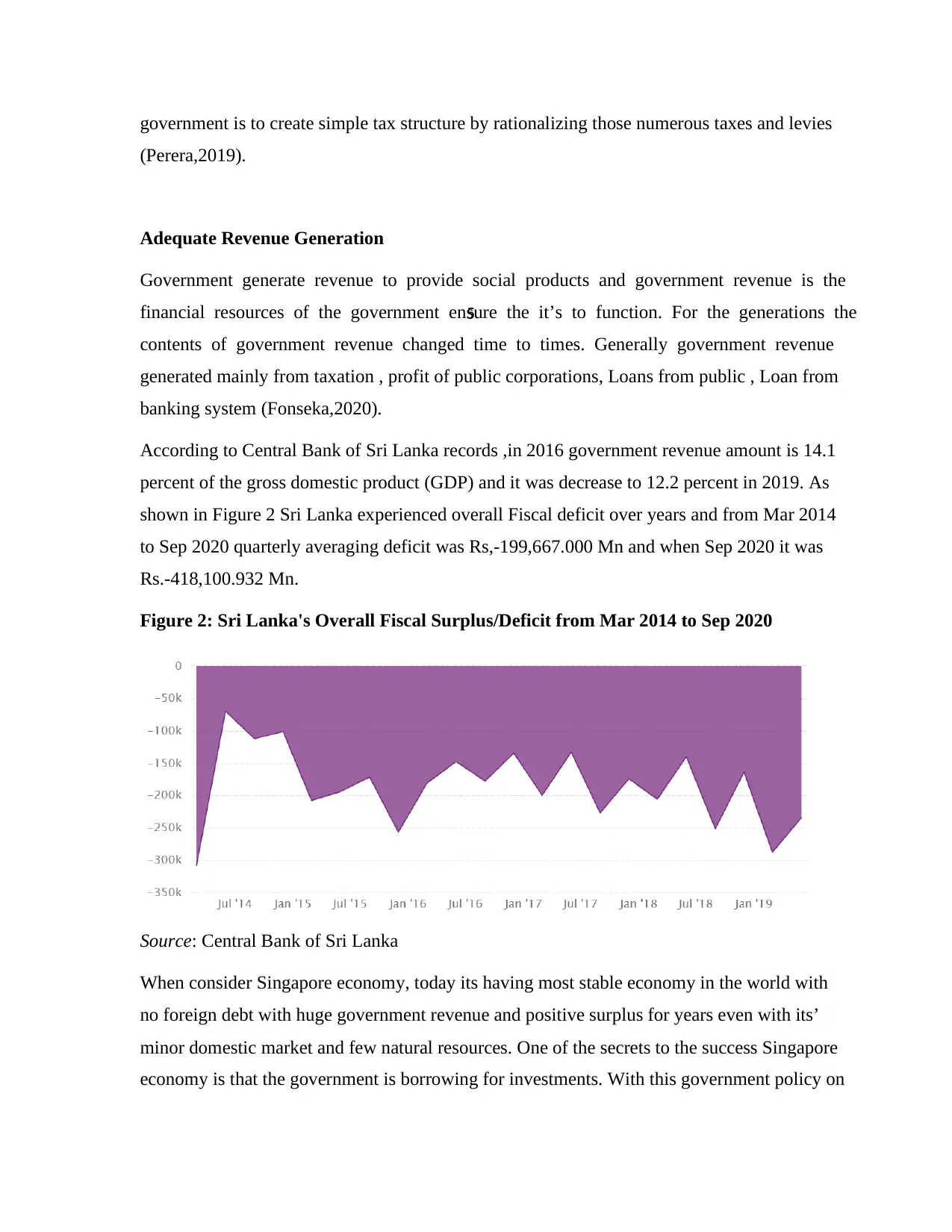
government is to create simple tax structure by rationalizing those numerous taxes and levies
(Perera,2019).
Adequate Revenue Generation
Government generate revenue to provide social products and government revenue is the
financial resources of the government ensure the it’s to function. For the generations the
contents of government revenue changed time to times. Generally government revenue
generated mainly from taxation , profit of public corporations, Loans from public , Loan from
banking system (Fonseka,2020).
According to Central Bank of Sri Lanka records ,in 2016 government revenue amount is 14.1
percent of the gross domestic product (GDP) and it was decrease to 12.2 percent in 2019. As
shown in Figure 2 Sri Lanka experienced overall Fiscal deficit over years and from Mar 2014
to Sep 2020 quarterly averaging deficit was Rs,-199,667.000 Mn and when Sep 2020 it was
Rs.-418,100.932 Mn.
Figure 2: Sri Lanka's Overall Fiscal Surplus/Deficit from Mar 2014 to Sep 2020
Source: Central Bank of Sri Lanka
When consider Singapore economy, today its having most stable economy in the world with
no foreign debt with huge government revenue and positive surplus for years even with its’
minor domestic market and few natural resources. One of the secrets to the success Singapore
economy is that the government is borrowing for investments. With this government policy on
5
(Perera,2019).
Adequate Revenue Generation
Government generate revenue to provide social products and government revenue is the
financial resources of the government ensure the it’s to function. For the generations the
contents of government revenue changed time to times. Generally government revenue
generated mainly from taxation , profit of public corporations, Loans from public , Loan from
banking system (Fonseka,2020).
According to Central Bank of Sri Lanka records ,in 2016 government revenue amount is 14.1
percent of the gross domestic product (GDP) and it was decrease to 12.2 percent in 2019. As
shown in Figure 2 Sri Lanka experienced overall Fiscal deficit over years and from Mar 2014
to Sep 2020 quarterly averaging deficit was Rs,-199,667.000 Mn and when Sep 2020 it was
Rs.-418,100.932 Mn.
Figure 2: Sri Lanka's Overall Fiscal Surplus/Deficit from Mar 2014 to Sep 2020
Source: Central Bank of Sri Lanka
When consider Singapore economy, today its having most stable economy in the world with
no foreign debt with huge government revenue and positive surplus for years even with its’
minor domestic market and few natural resources. One of the secrets to the success Singapore
economy is that the government is borrowing for investments. With this government policy on
5
⊘ This is a preview!⊘
Do you want full access?
Subscribe today to unlock all pages.

Trusted by 1+ million students worldwide
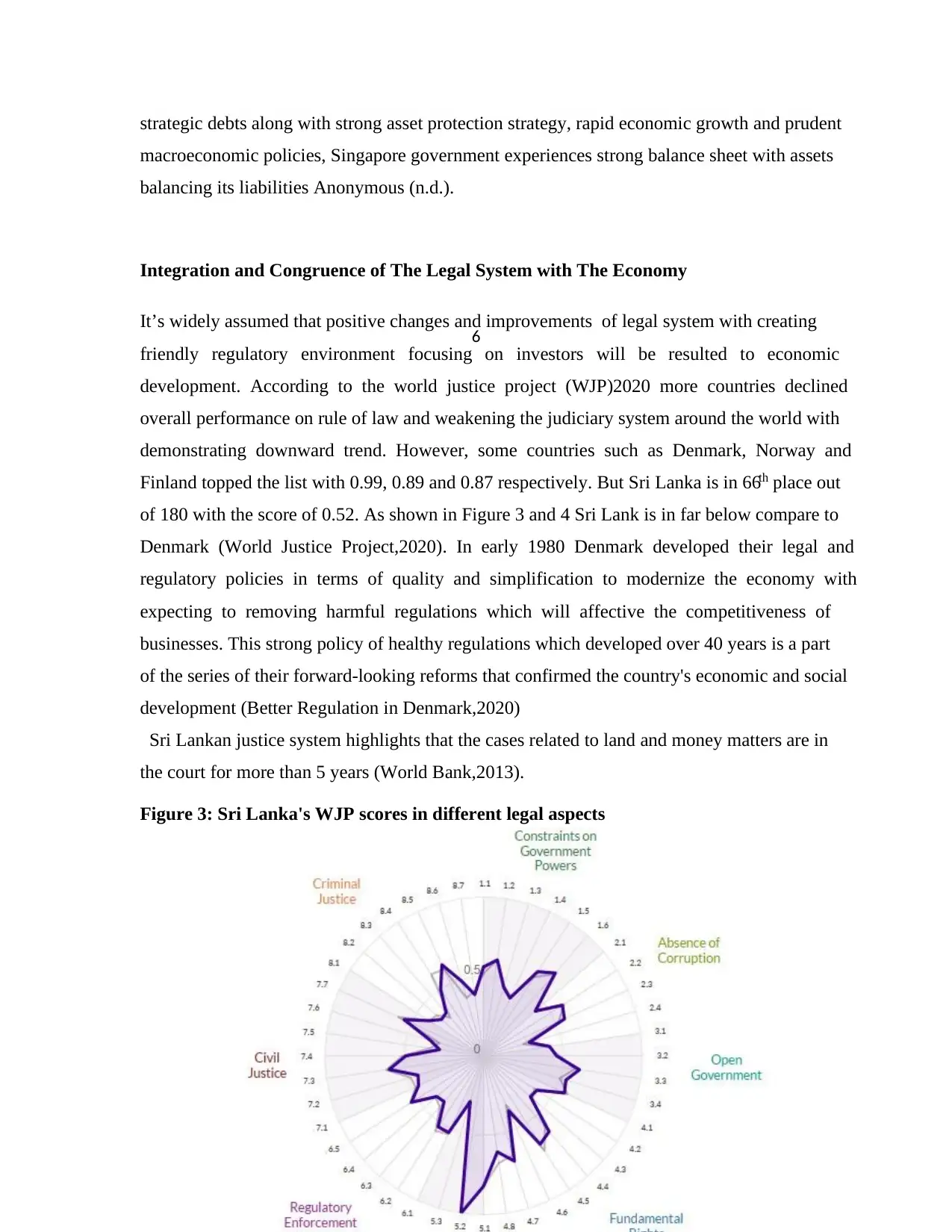
strategic debts along with strong asset protection strategy, rapid economic growth and prudent
macroeconomic policies, Singapore government experiences strong balance sheet with assets
balancing its liabilities Anonymous (n.d.).
Integration and Congruence of The Legal System with The Economy
It’s widely assumed that positive changes and improvements of legal system with creating
friendly regulatory environment focusing on investors will be resulted to economic
development. According to the world justice project (WJP)2020 more countries declined
overall performance on rule of law and weakening the judiciary system around the world with
demonstrating downward trend. However, some countries such as Denmark, Norway and
Finland topped the list with 0.99, 0.89 and 0.87 respectively. But Sri Lanka is in 66th place out
of 180 with the score of 0.52. As shown in Figure 3 and 4 Sri Lank is in far below compare to
Denmark (World Justice Project,2020). In early 1980 Denmark developed their legal and
regulatory policies in terms of quality and simplification to modernize the economy with
expecting to removing harmful regulations which will affective the competitiveness of
businesses. This strong policy of healthy regulations which developed over 40 years is a part
of the series of their forward-looking reforms that confirmed the country's economic and social
development (Better Regulation in Denmark,2020)
Sri Lankan justice system highlights that the cases related to land and money matters are in
the court for more than 5 years (World Bank,2013).
Figure 3: Sri Lanka's WJP scores in different legal aspects
6
macroeconomic policies, Singapore government experiences strong balance sheet with assets
balancing its liabilities Anonymous (n.d.).
Integration and Congruence of The Legal System with The Economy
It’s widely assumed that positive changes and improvements of legal system with creating
friendly regulatory environment focusing on investors will be resulted to economic
development. According to the world justice project (WJP)2020 more countries declined
overall performance on rule of law and weakening the judiciary system around the world with
demonstrating downward trend. However, some countries such as Denmark, Norway and
Finland topped the list with 0.99, 0.89 and 0.87 respectively. But Sri Lanka is in 66th place out
of 180 with the score of 0.52. As shown in Figure 3 and 4 Sri Lank is in far below compare to
Denmark (World Justice Project,2020). In early 1980 Denmark developed their legal and
regulatory policies in terms of quality and simplification to modernize the economy with
expecting to removing harmful regulations which will affective the competitiveness of
businesses. This strong policy of healthy regulations which developed over 40 years is a part
of the series of their forward-looking reforms that confirmed the country's economic and social
development (Better Regulation in Denmark,2020)
Sri Lankan justice system highlights that the cases related to land and money matters are in
the court for more than 5 years (World Bank,2013).
Figure 3: Sri Lanka's WJP scores in different legal aspects
6
Paraphrase This Document
Need a fresh take? Get an instant paraphrase of this document with our AI Paraphraser
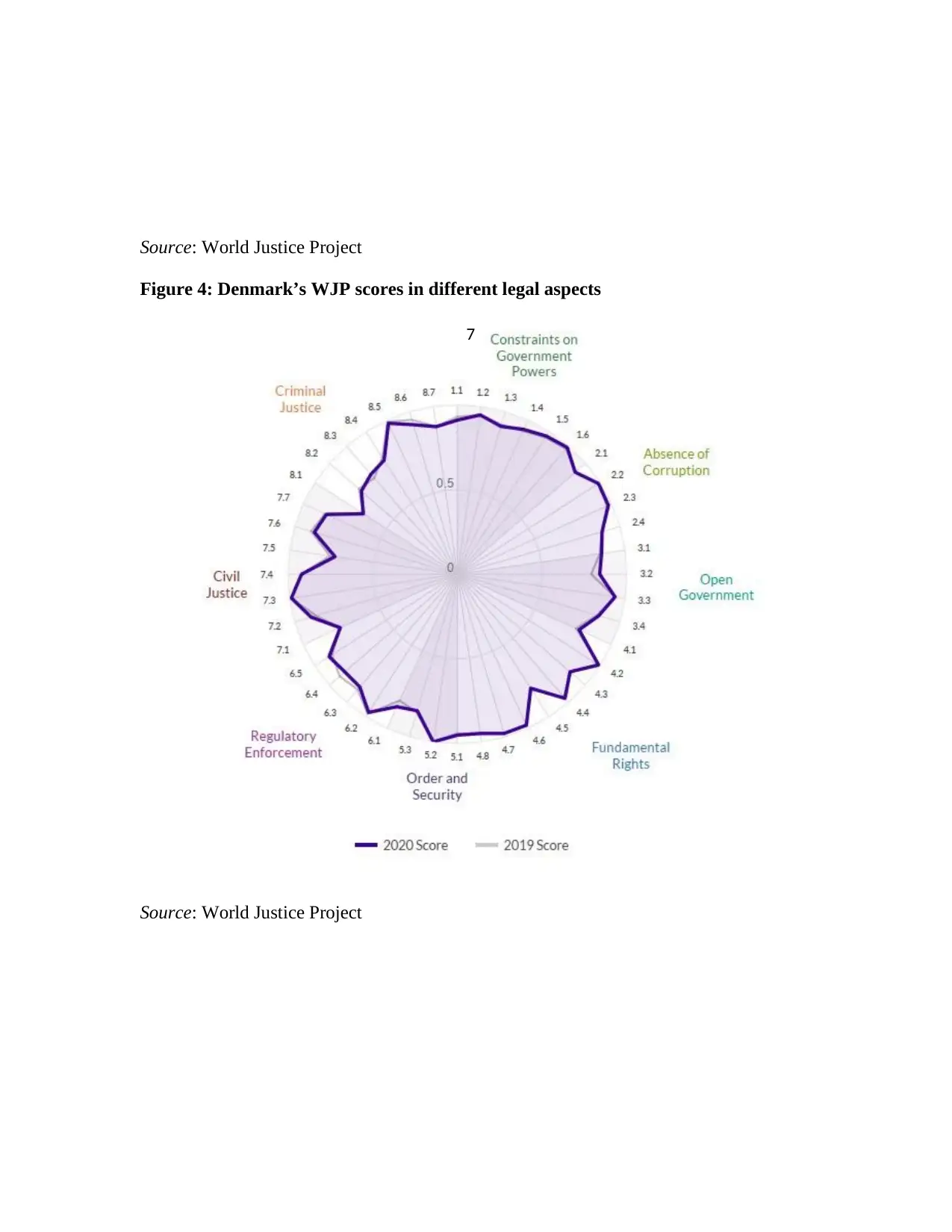
Source: World Justice Project
Figure 4: Denmark’s WJP scores in different legal aspects
Source: World Justice Project
7
Figure 4: Denmark’s WJP scores in different legal aspects
Source: World Justice Project
7
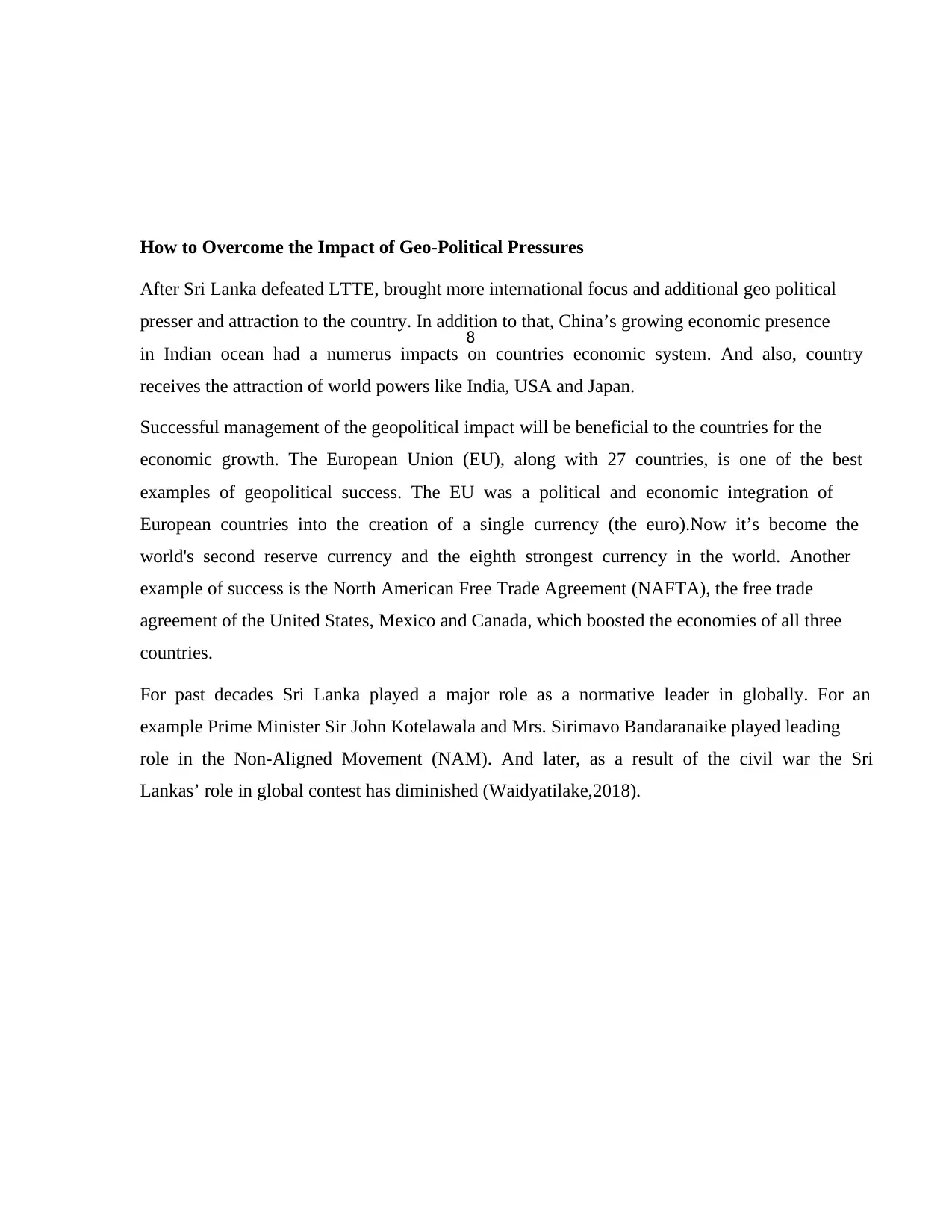
How to Overcome the Impact of Geo-Political Pressures
After Sri Lanka defeated LTTE, brought more international focus and additional geo political
presser and attraction to the country. In addition to that, China’s growing economic presence
in Indian ocean had a numerus impacts on countries economic system. And also, country
receives the attraction of world powers like India, USA and Japan.
Successful management of the geopolitical impact will be beneficial to the countries for the
economic growth. The European Union (EU), along with 27 countries, is one of the best
examples of geopolitical success. The EU was a political and economic integration of
European countries into the creation of a single currency (the euro).Now it’s become the
world's second reserve currency and the eighth strongest currency in the world. Another
example of success is the North American Free Trade Agreement (NAFTA), the free trade
agreement of the United States, Mexico and Canada, which boosted the economies of all three
countries.
For past decades Sri Lanka played a major role as a normative leader in globally. For an
example Prime Minister Sir John Kotelawala and Mrs. Sirimavo Bandaranaike played leading
role in the Non-Aligned Movement (NAM). And later, as a result of the civil war the Sri
Lankas’ role in global contest has diminished (Waidyatilake,2018).
8
After Sri Lanka defeated LTTE, brought more international focus and additional geo political
presser and attraction to the country. In addition to that, China’s growing economic presence
in Indian ocean had a numerus impacts on countries economic system. And also, country
receives the attraction of world powers like India, USA and Japan.
Successful management of the geopolitical impact will be beneficial to the countries for the
economic growth. The European Union (EU), along with 27 countries, is one of the best
examples of geopolitical success. The EU was a political and economic integration of
European countries into the creation of a single currency (the euro).Now it’s become the
world's second reserve currency and the eighth strongest currency in the world. Another
example of success is the North American Free Trade Agreement (NAFTA), the free trade
agreement of the United States, Mexico and Canada, which boosted the economies of all three
countries.
For past decades Sri Lanka played a major role as a normative leader in globally. For an
example Prime Minister Sir John Kotelawala and Mrs. Sirimavo Bandaranaike played leading
role in the Non-Aligned Movement (NAM). And later, as a result of the civil war the Sri
Lankas’ role in global contest has diminished (Waidyatilake,2018).
8
⊘ This is a preview!⊘
Do you want full access?
Subscribe today to unlock all pages.

Trusted by 1+ million students worldwide
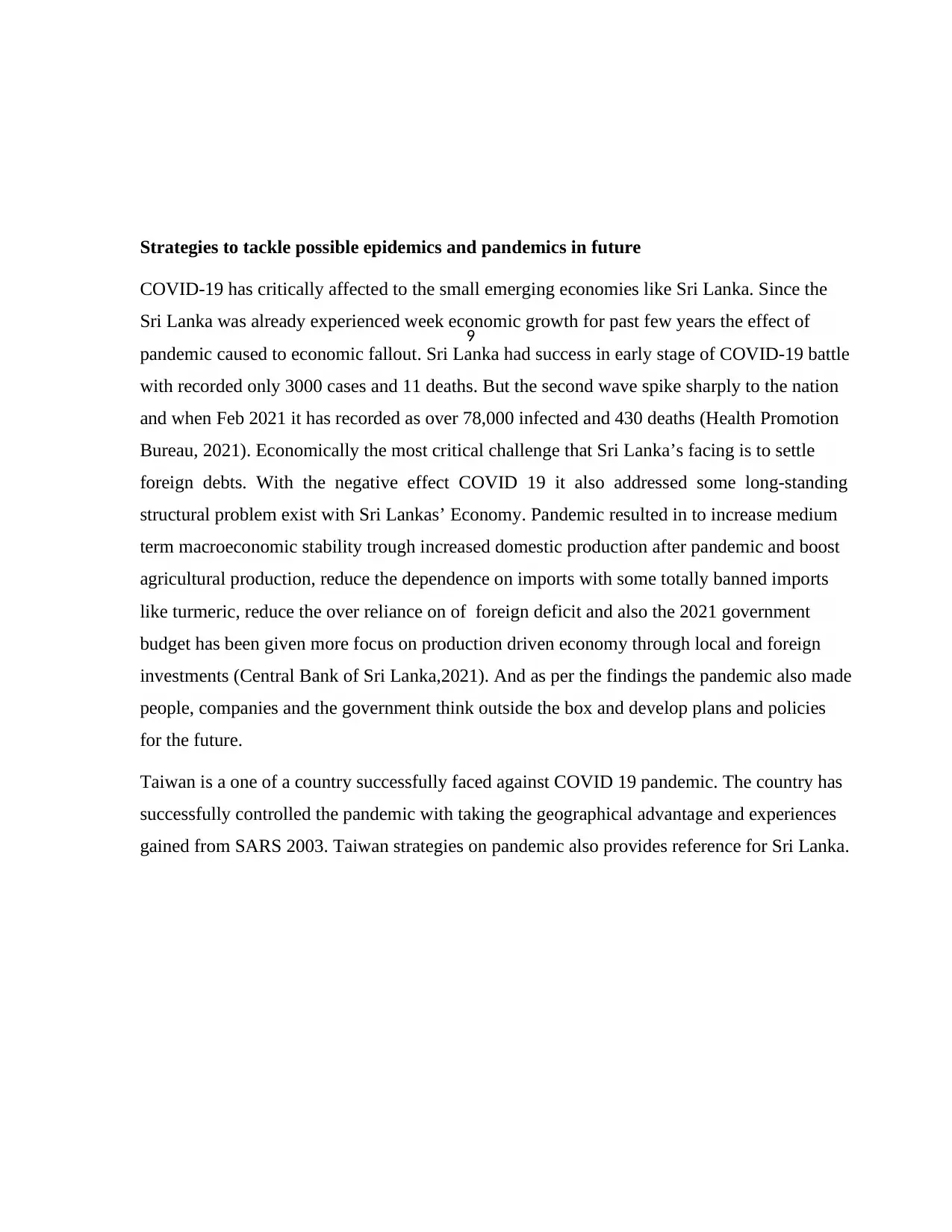
Strategies to tackle possible epidemics and pandemics in future
COVID-19 has critically affected to the small emerging economies like Sri Lanka. Since the
Sri Lanka was already experienced week economic growth for past few years the effect of
pandemic caused to economic fallout. Sri Lanka had success in early stage of COVID-19 battle
with recorded only 3000 cases and 11 deaths. But the second wave spike sharply to the nation
and when Feb 2021 it has recorded as over 78,000 infected and 430 deaths (Health Promotion
Bureau, 2021). Economically the most critical challenge that Sri Lanka’s facing is to settle
foreign debts. With the negative effect COVID 19 it also addressed some long-standing
structural problem exist with Sri Lankas’ Economy. Pandemic resulted in to increase medium
term macroeconomic stability trough increased domestic production after pandemic and boost
agricultural production, reduce the dependence on imports with some totally banned imports
like turmeric, reduce the over reliance on of foreign deficit and also the 2021 government
budget has been given more focus on production driven economy through local and foreign
investments (Central Bank of Sri Lanka,2021). And as per the findings the pandemic also made
people, companies and the government think outside the box and develop plans and policies
for the future.
Taiwan is a one of a country successfully faced against COVID 19 pandemic. The country has
successfully controlled the pandemic with taking the geographical advantage and experiences
gained from SARS 2003. Taiwan strategies on pandemic also provides reference for Sri Lanka.
9
COVID-19 has critically affected to the small emerging economies like Sri Lanka. Since the
Sri Lanka was already experienced week economic growth for past few years the effect of
pandemic caused to economic fallout. Sri Lanka had success in early stage of COVID-19 battle
with recorded only 3000 cases and 11 deaths. But the second wave spike sharply to the nation
and when Feb 2021 it has recorded as over 78,000 infected and 430 deaths (Health Promotion
Bureau, 2021). Economically the most critical challenge that Sri Lanka’s facing is to settle
foreign debts. With the negative effect COVID 19 it also addressed some long-standing
structural problem exist with Sri Lankas’ Economy. Pandemic resulted in to increase medium
term macroeconomic stability trough increased domestic production after pandemic and boost
agricultural production, reduce the dependence on imports with some totally banned imports
like turmeric, reduce the over reliance on of foreign deficit and also the 2021 government
budget has been given more focus on production driven economy through local and foreign
investments (Central Bank of Sri Lanka,2021). And as per the findings the pandemic also made
people, companies and the government think outside the box and develop plans and policies
for the future.
Taiwan is a one of a country successfully faced against COVID 19 pandemic. The country has
successfully controlled the pandemic with taking the geographical advantage and experiences
gained from SARS 2003. Taiwan strategies on pandemic also provides reference for Sri Lanka.
9
Paraphrase This Document
Need a fresh take? Get an instant paraphrase of this document with our AI Paraphraser
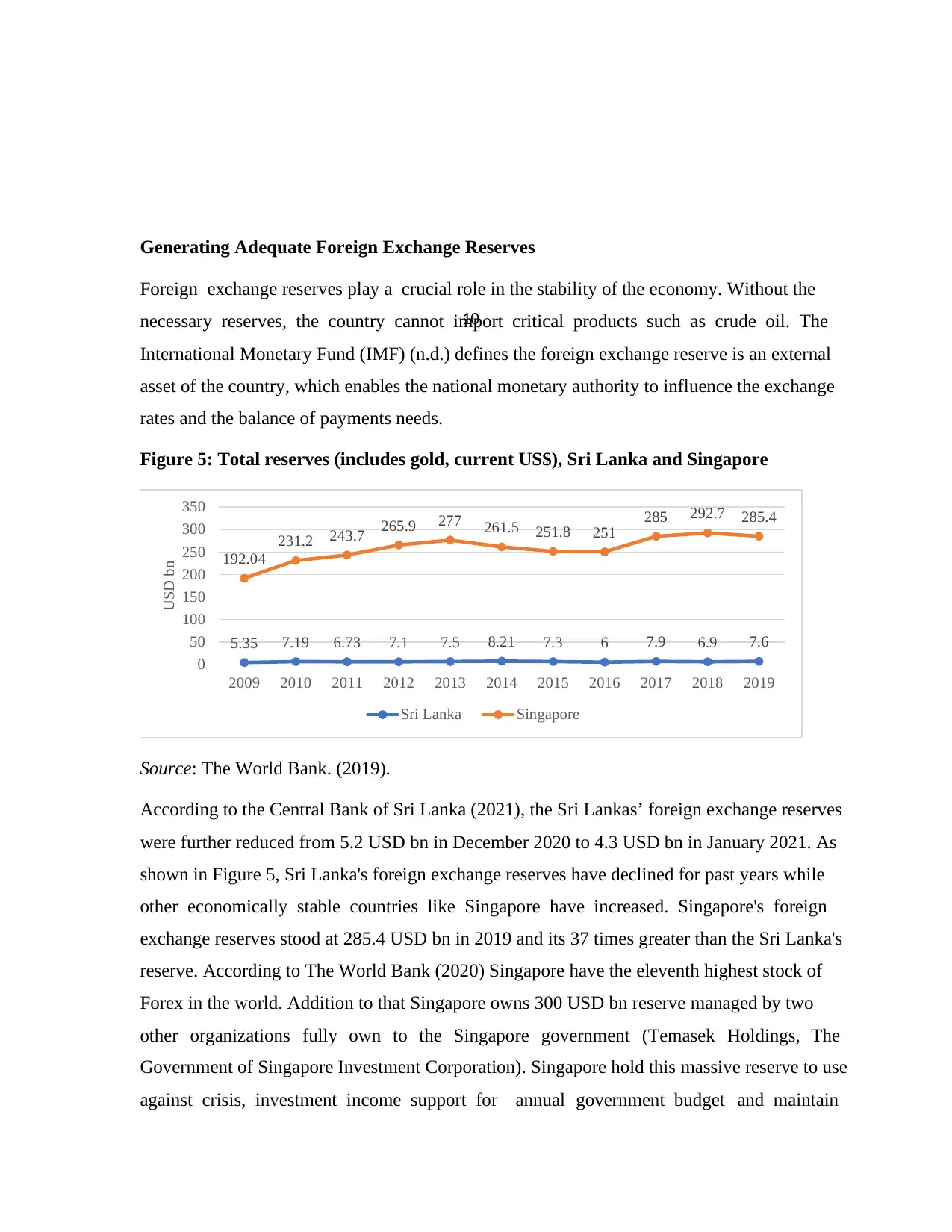
Generating Adequate Foreign Exchange Reserves
Foreign exchange reserves play a crucial role in the stability of the economy. Without the
necessary reserves, the country cannot import critical products such as crude oil. The
International Monetary Fund (IMF) (n.d.) defines the foreign exchange reserve is an external
asset of the country, which enables the national monetary authority to influence the exchange
rates and the balance of payments needs.
Figure 5: Total reserves (includes gold, current US$), Sri Lanka and Singapore
Source: The World Bank. (2019).
According to the Central Bank of Sri Lanka (2021), the Sri Lankas’ foreign exchange reserves
were further reduced from 5.2 USD bn in December 2020 to 4.3 USD bn in January 2021. As
shown in Figure 5, Sri Lanka's foreign exchange reserves have declined for past years while
other economically stable countries like Singapore have increased. Singapore's foreign
exchange reserves stood at 285.4 USD bn in 2019 and its 37 times greater than the Sri Lanka's
reserve. According to The World Bank (2020) Singapore have the eleventh highest stock of
Forex in the world. Addition to that Singapore owns 300 USD bn reserve managed by two
other organizations fully own to the Singapore government (Temasek Holdings, The
Government of Singapore Investment Corporation). Singapore hold this massive reserve to use
against crisis, investment income support for annual government budget and maintain
5.35 7.19 6.73 7.1 7.5 8.21 7.3 6 7.9 6.9 7.6
192.04
231.2 243.7 265.9 277 261.5 251.8 251
285 292.7 285.4
0
50
100
150
200
250
300
350
2009 2010 2011 2012 2013 2014 2015 2016 2017 2018 2019
USD bn
Sri Lanka Singapore
10
Foreign exchange reserves play a crucial role in the stability of the economy. Without the
necessary reserves, the country cannot import critical products such as crude oil. The
International Monetary Fund (IMF) (n.d.) defines the foreign exchange reserve is an external
asset of the country, which enables the national monetary authority to influence the exchange
rates and the balance of payments needs.
Figure 5: Total reserves (includes gold, current US$), Sri Lanka and Singapore
Source: The World Bank. (2019).
According to the Central Bank of Sri Lanka (2021), the Sri Lankas’ foreign exchange reserves
were further reduced from 5.2 USD bn in December 2020 to 4.3 USD bn in January 2021. As
shown in Figure 5, Sri Lanka's foreign exchange reserves have declined for past years while
other economically stable countries like Singapore have increased. Singapore's foreign
exchange reserves stood at 285.4 USD bn in 2019 and its 37 times greater than the Sri Lanka's
reserve. According to The World Bank (2020) Singapore have the eleventh highest stock of
Forex in the world. Addition to that Singapore owns 300 USD bn reserve managed by two
other organizations fully own to the Singapore government (Temasek Holdings, The
Government of Singapore Investment Corporation). Singapore hold this massive reserve to use
against crisis, investment income support for annual government budget and maintain
5.35 7.19 6.73 7.1 7.5 8.21 7.3 6 7.9 6.9 7.6
192.04
231.2 243.7 265.9 277 261.5 251.8 251
285 292.7 285.4
0
50
100
150
200
250
300
350
2009 2010 2011 2012 2013 2014 2015 2016 2017 2018 2019
USD bn
Sri Lanka Singapore
10
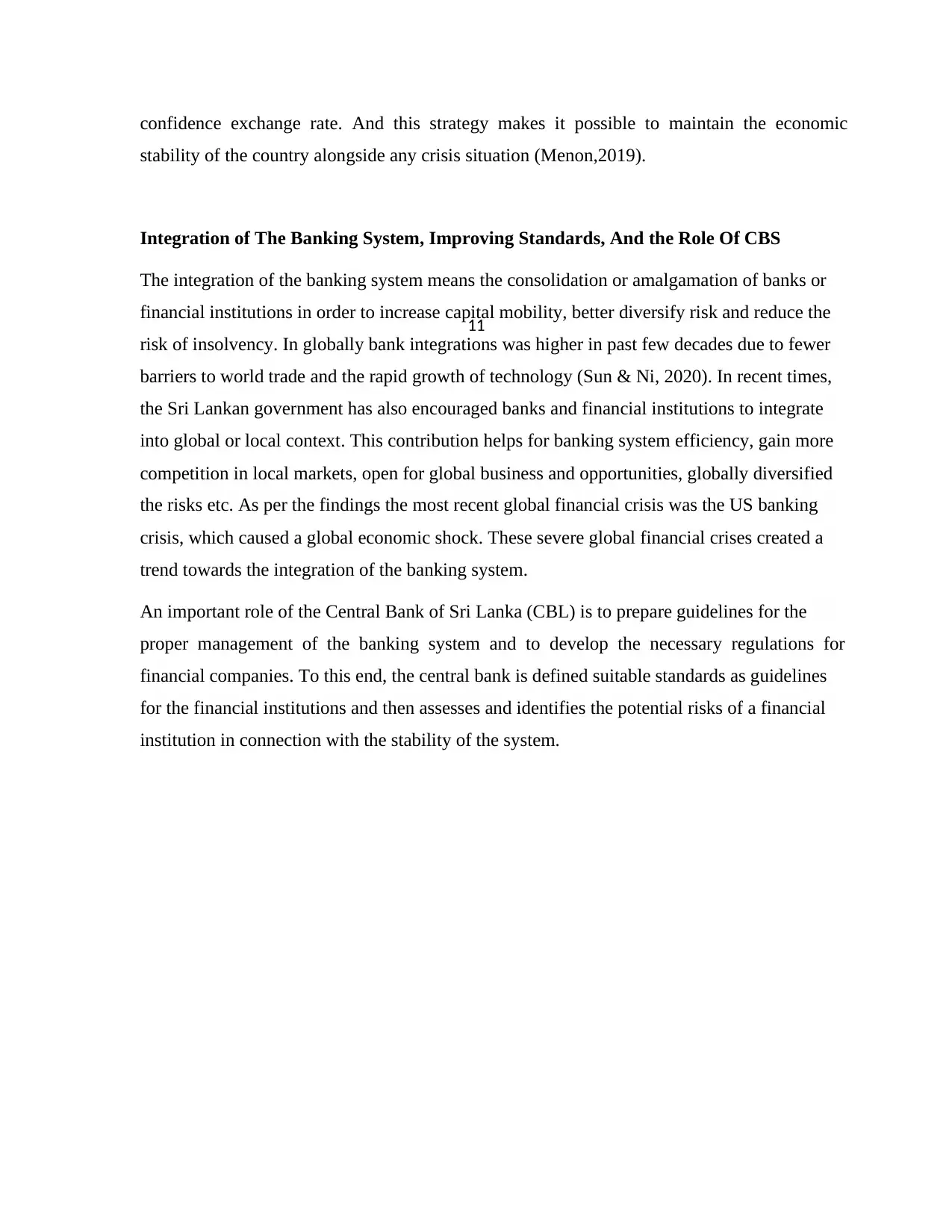
confidence exchange rate. And this strategy makes it possible to maintain the economic
stability of the country alongside any crisis situation (Menon,2019).
Integration of The Banking System, Improving Standards, And the Role Of CBS
The integration of the banking system means the consolidation or amalgamation of banks or
financial institutions in order to increase capital mobility, better diversify risk and reduce the
risk of insolvency. In globally bank integrations was higher in past few decades due to fewer
barriers to world trade and the rapid growth of technology (Sun & Ni, 2020). In recent times,
the Sri Lankan government has also encouraged banks and financial institutions to integrate
into global or local context. This contribution helps for banking system efficiency, gain more
competition in local markets, open for global business and opportunities, globally diversified
the risks etc. As per the findings the most recent global financial crisis was the US banking
crisis, which caused a global economic shock. These severe global financial crises created a
trend towards the integration of the banking system.
An important role of the Central Bank of Sri Lanka (CBL) is to prepare guidelines for the
proper management of the banking system and to develop the necessary regulations for
financial companies. To this end, the central bank is defined suitable standards as guidelines
for the financial institutions and then assesses and identifies the potential risks of a financial
institution in connection with the stability of the system.
11
stability of the country alongside any crisis situation (Menon,2019).
Integration of The Banking System, Improving Standards, And the Role Of CBS
The integration of the banking system means the consolidation or amalgamation of banks or
financial institutions in order to increase capital mobility, better diversify risk and reduce the
risk of insolvency. In globally bank integrations was higher in past few decades due to fewer
barriers to world trade and the rapid growth of technology (Sun & Ni, 2020). In recent times,
the Sri Lankan government has also encouraged banks and financial institutions to integrate
into global or local context. This contribution helps for banking system efficiency, gain more
competition in local markets, open for global business and opportunities, globally diversified
the risks etc. As per the findings the most recent global financial crisis was the US banking
crisis, which caused a global economic shock. These severe global financial crises created a
trend towards the integration of the banking system.
An important role of the Central Bank of Sri Lanka (CBL) is to prepare guidelines for the
proper management of the banking system and to develop the necessary regulations for
financial companies. To this end, the central bank is defined suitable standards as guidelines
for the financial institutions and then assesses and identifies the potential risks of a financial
institution in connection with the stability of the system.
11
⊘ This is a preview!⊘
Do you want full access?
Subscribe today to unlock all pages.

Trusted by 1+ million students worldwide
1 out of 20
Related Documents
Your All-in-One AI-Powered Toolkit for Academic Success.
+13062052269
info@desklib.com
Available 24*7 on WhatsApp / Email
![[object Object]](/_next/static/media/star-bottom.7253800d.svg)
Unlock your academic potential
Copyright © 2020–2025 A2Z Services. All Rights Reserved. Developed and managed by ZUCOL.



